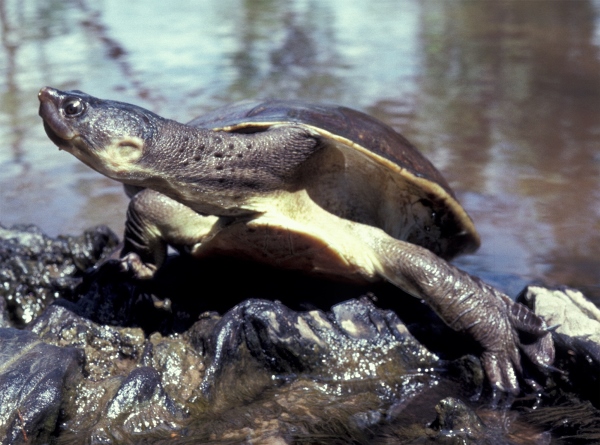Marcus Butler
8 January 2016: The world’s understanding of Australian wildlife has been improved through the research of University of Canberra Master of Applied Science graduate Scott Thomson, who has described a new species of turtle.
Having spent more than a decade with the University’s Institute for Applied Ecology, Mr Thomson has described seven new species in total, but says his latest, the yellow bellied snapping turtle (Elseya flaviventralis), published in Zootaxa, feels like he’s left a mark on scientific history.
"So much of science sees new discoveries overwrite our previous knowledge, but with taxonomy (the science of classifying organisms) the original description is forever,” Mr Thomson said.
“The description names the species; it presents this new animal to science and the world. For the authors of a species description, it is a permanent mark on science. It’s an incredible feeling.”
The yellow bellied snapping turtle is found in the Arnhem Land region of the Northern Territory, particularly in the Mary, South Alligator, East Alligator, Goyder and Mann River areas.
“I put a lot of effort into the description of the species, as it requires a lot of precision,” Mr Thomson added. “E. flaviventralis is a large turtle about 35cm along its shell. It has a brown shell with a yellow belly, which led to its name. Almost all snapping turtles have black staining on their belly plates, but this new species is the exception.
“It is a river turtle and it’s built for this region of the world with a very strong shell that is highly resistant to impact, such as being bitten by a crocodile.”
Mr Thomson focused his masters on an analysis of the entire genus of snapping turtles or Elseya and involved visiting museums around the world to catalogue their original specimens (holotype).
“I measured and recorded many thousands of specimens, and acquired skeletons of every Australian species,” he said. “Whenever I visited a museum to access their holotypes, I would spend extra time cataloguing every other turtle they had in their collection, to add to the dataset.
"Combined with the research of my masters supervisor Distinguished Professor Arthur Georges, who has been working on the molecular and DNA data of turtles, we ended up with a massive amount of information.”
Professor Georges, renowned for his own work on reptiles, including his Piku project protecting vulnerable freshwater pig-nosed turtles in Papua New Guinea, said the research has benefitted many of Australia’s turtle species.
“It has been critical in bringing the plight of many of these species, some vulnerable, some endangered, some even critically endangered, to the attention of authorities with responsibility for their conservation,” he said.
“Scott has achieved something wonderful, improving our understanding of the world around us, and I know that he’s enjoyed himself in the process.”
Since his graduation in 2015, Mr Thomson has commenced a PhD on fossilised side-necked turtles with the Museu de Zoologia in São Paulo, Brazil.
He is also actively involved in reptile nomenclatural issues and a member of two checklists for turtles run by the International Union for Conservation of Nature Tortoise and Freshwater Turtle Specialist Group.



